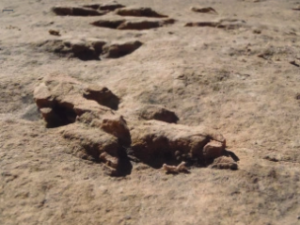 A short, toe-numbing wade across the chai tea latte textured Dirty Devil River on this clear morning was as far as our feet needed to take us away from our campsite. “There’s a really cool surprise around here,” our amazing professor Katie announced as we reached the sandy, willow covered bank.
A short, toe-numbing wade across the chai tea latte textured Dirty Devil River on this clear morning was as far as our feet needed to take us away from our campsite. “There’s a really cool surprise around here,” our amazing professor Katie announced as we reached the sandy, willow covered bank.
We had heard this statement before on previous day hikes. Katie never lies about cool things as she has generously led us to ancient petroglyphs and creamy slot canyons. We spread out across the floodplain in search of the next experience that would make our hearts beat fast.
After scurrying around the soft sand bank with passion for new discoveries and tall rusty walls encompassing our views, cheers of delight echoed off the canyon walls as we found the next cool thing. There, sitting prominently amongst the cheatgrass and sagebrush, a fallen table of sandstone protruded up towards the sky. Multi-directional dinosaur tracks stared up at us inverted on the sandstone table. Overhangs on the sandstone layers above us flaunted more foot tracks. These prints were preserved in this sandstone layer for over 200 million years! As I placed my palm on one of the perfectly preserved three-toed ancient footprints, a million questions raced through my mind. How did these tracks get here? Were these goose sized tracks baby dinosaurs or fully grown? The dinosaurs who laid down these tracks could have never imagined that, more two hundred million years later, our group of college students would stumble across them. What were they doing? What were they thinking?
Finding a moment in time captured by environmental forces gave us all a sense of awe and wonder. Imagining small, turkey-sized dinosaurs running across the mudflats of the time made me wonder what other sorts of secrets the flaky, red rock layers held.
The dinosaur tracks, which fit in our palms, were made by Grallator. This genus is unique because it is an ichnogenera, only identified by its preserved tracks. Paleontologists assume them to be adults. The multiple tracks we saw were thought to have been laid down at different times.
How can two very different species reach the same moment in time in two vastly different worlds? Rocks. The answer we seek is held in the abiotic, mineral substance of our world. Rocks are capsules of time, which are moved by wind and water, transformed everyday, every year, every century to give us glimpses into the past. Grallator tracks, inverted towards us were quickly preserved by sand particles filling the depressions in the mud and exposed by erosional forces allowing us to reach the mudflat, tropical environment Grallator once thrived upon.
Just as the sculptor molds their next creation, the wind and water acting on the grains of sand shape moments in time. Wind and water mirror the sculptor’s work as they gnaw away, layer by layer, at the rock formations to expose biological existence. These erosional forces gave way to Grallator tracks allowing us to fall, palm to palm, with this ancient species.
The sculpture of the Colorado Plateau is a unique story. A long time ago, the preserved Grallator tracks sat 4 to 6 thousand feet lower in elevation. The whole plateau once sat much below my feet and held unfathomable life forms. Five million years ago, forces deep within the earth shuttered raising this section of crust to the wind and water sculptors, exposing the past.
Evidence of you, me, and the Grallator species can be preserved in these mineral sculptures. Our biological properties give us an endpoint. The crystal grains of silt and sand are continually sculpted into moments in time, which are preserved beyond our existence. The rock creations cannot be interpreted on their own. They need us, the living, breathing, multi-cellular organisms to examine the earthen sculptures they mold. The Colorado Plateau provides a body of artwork in which the wind and water sculptors present us with a looking glass into almost 200 million years of time. Biological existence is a small window compared to the rocky sculptures whose art forms are strong and more stable throughout generations. These unique places and erosional forces allow two drastically different environmental times to collide giving us a sense of the past.